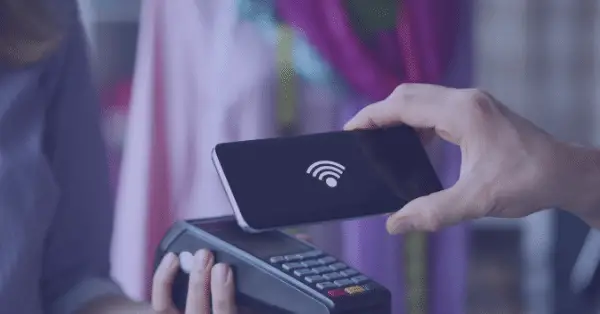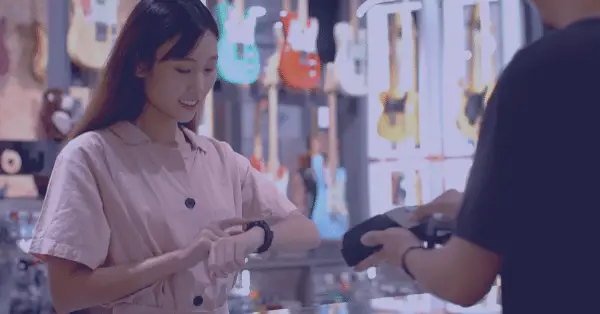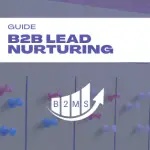Leveraging Point-of-Sale Marketing effectively
What is Point-of-Sale Marketing? (POS Marketing Definition)
Point-of-sale marketing (short POS marketing) is a method of sales promotion in retail directly at the point of purchase. The goal is to generate up-sells by marketing products effectively. These can be directly in the moment of purchase, but can also be aimed at future sales.

Classic point-of-sale marketing in stationary retail
In supermarkets, hospitality, or fashion retailers, you can always find tangible products while waiting in line to pay at the checkout counter. In addition, you often see eye-catching advertising banners with discounts and special offers that quickly encourage you to make an additional purchase.
These products and offers are not necessarily chosen because they are small and still fit quickly into the already full shopping basket, but also through targeted product placement to incentivize impulse purchases. POS marketing analyzes the correct products and couples it often with offers, like 3 for the price for 2 to even up-sell the Up-Sell.
However, there are not only products at the point of sale, but also methods for long-term customer loyalty, such as loyalty programs, gift cards, sweepstakes, or coupons for the next purchase.
Digital point-of-sale marketing
Point-of-sale marketing includes not only placing products and promotional messages at and around a checkout, but also digital media. Discounts can be redeemed through QR codes or online coupons. Even the cash register receipt can become a POS marketing tool.
- The paper receipt links into the digital world through scannable QR codes or unique links – often in combination with a sweepstakes code.
- The digital receipt with automatic product placements, digital wheels of fortune, or automatic loyalty programs. In addition, the digital receipt is carbon neutral and can be longer than its paper predecessor, saving resources. Paid advertising messages can be an additional source of revenue. More on this later.
POS marketing in e-commerce
Point-of-sale marketing also exists in online retail. However, it is somewhat different than in brick-and-mortar retail. Often much more personalized and relevant through targeted marketing actions based on the user profile (for known, returning customers) or selected products.
Often there is a conversion or up-sell funnel in eCommerce, which increases sales per purchase process through a few clicks, and ultimately optimizes the CPO (cost per order).
Either on the product page, in the shopping cart, at the online checkout, or even after the completed purchase, there is the possibility of POS marketing.
POS marketing on the product side: On the product side, bundles or similar products are often offered. While similar products may even distract from the purchase, bundle offers create the opposite. A cookbook can quickly become a matching apron and spice rack.
Bulk discounts and subscriptions can also be offered. 3 for the price of 2, 10% discount or free delivery are incentives to buy more. Automatic repeat purchases, so called subscriptions, are also a good marketing tactic in e-commerce point-of-sale marketing to retain customers in the long term and turn a single purchase into a 3-month or even yearly business.
Scarcity and even artificial scarcity such as a time limit on a discount, or limited availability of an item create an urgency in the buyer and influence them to make an impulse buying decision.
POS marketing in the online shopping cart: In the shopping cart itself, additional products and offers can be marketed. “Add these products quickly”. The goal is either to increase the quantity of previous items or to add additional products. Often similar products are suggested, or products that you have previously viewed but not purchased.
Point of Sale Marketing at online checkout: When you go to the checkout in the online store you often get many more opportunities to spend money.
Upsells and cross sells to other services related to the product (e.g. insurance, fast delivery), subscriptions for monthly recurring purchases, or memberships (e.g. Amazon Prime) are the most common upsell methods in POS online marketing.

Product recommendations based on real buying behavior
We all know it: When we look at a product on an e-commerce website, we directly see alternatives, or even products that are closely related to the product. In the case of a chainsaw, for example, this could be an accompanying carving glove. For a BluRay, it could be another movie starring the main actor, or a fan shirt. While most products are closely related, there are also recommendations based on real buying behavior. This involves analyzing actual purchases and making recommendations because others have made that exact combination in one or recurring purchases.
This sounds like an algorithm only available in online retail, but it has long been possible at brick-and-mortar point of sales as well. However, it is more difficult to recommend a product to the customer. In the online store, the shopper sees other items. In stationary retail, digital POS marketing is required. Theoretically, these recommendations can be represented by coupons or on the receipt, but then the buying process is completed and relies on a repeat purchase. Through modern point-of-sale marketing on the smartphone, products can be recommended before the check-out is completed.
Lastly, items that a customer has already looked at before can be advertised.
Point-of-sale advertising
POS advertising is a two-sided sword. On the one hand, companies want to market their products, and on the other hand, it is a way for retailers to generate additional revenue. This can be realized through direct sales of the advertising space, better margins on a sale, or more sales volume overall.
However, we need to break away from traditional types of advertising when it comes to POS advertising. Of course, a potato chips manufacturer can hang a poster near the cash register and pos system. But there are also new POS advertising channels and formats: On the digital receipt. Here, digital banners, offers, or specials can be targeted to people who are relevant to the advertiser. It’s targeted advertising with less wastage. By the way, relevance is one of the most important principles of advertising.
For example, a campaign can be that every customer who buys a competitor’s products gets a free product sample with the next purchase.
POS interactions and data
To achieve more customer engagement, marketers increasingly rely on interactions at the point of purchase. POS promotions and POS marketing actions such as sweepstakes or reward campaigns are already widespread.
Often, however, the goal is not only to generate additional purchases at the very moment, but also to collect data in order to establish a direct relationship with the customer. When a customer shops in a supermarket or retail store, the marketer cannot know who that customer is or collect any demographic data. That’s why there are often promotions where a customer must register directly with the manufacturer. Technology manufacturers sometimes offer cash backs if you register the product on the manufacturer’s site.
However, POS marketing efforts also include the goal of increasing sales. Marketing campaigns like sweepstakes to get a direct discount or visual merchandising can be played out quickly and targeted, especially at the digital point of sale POS.

Sascha is a Lifecycle Marketing Consultant with over 8 years of digital marketing experiences in Silicon Valley, the UK, and Germany.
After leading the demand generation for a 100+ million company, he decided to venture out on himself. He’s now helping clients to attract and convert more leads and customers.
His main focus are SEO, paid media & marketing automation – all with the focus to tie marketing campaigns to revenue.
Sascha has been featured in industry publications.



